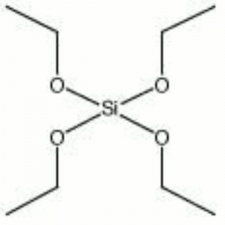Difference between revisions of "Ethyl silicate"
m (Text replace - "== Authority ==" to "== Sources Checked for Data in Record ==") |
|||
| (3 intermediate revisions by the same user not shown) | |||
| Line 2: | Line 2: | ||
A liquid silicate that hydrolyzes to form a colorless, transparent film of [[silica]]. For application, ethyl silicate is dissolved in an anhydrous [[ethyl alcohol|ethanol]] solution. Small amounts of water will cause the solution to gel. Once applied, moisture from the atmosphere initiates irreversible hydrolyzation producing a solid silica film in less than an hour. Ethyl silicate was introduced as a paint vehicle in England in 1931 for painting outdoor murals. It is used with [[alkali]] and [[acid]] resistant [[fresco pigments]]. The silicate colors are durable and resistant to weathering. More recently, ethyl silicate has been used for consolidating, strengthening and weatherproofing [[stone]], [[mortar (masonry)|mortars]], and [[cement|cements]]. | A liquid silicate that hydrolyzes to form a colorless, transparent film of [[silica]]. For application, ethyl silicate is dissolved in an anhydrous [[ethyl alcohol|ethanol]] solution. Small amounts of water will cause the solution to gel. Once applied, moisture from the atmosphere initiates irreversible hydrolyzation producing a solid silica film in less than an hour. Ethyl silicate was introduced as a paint vehicle in England in 1931 for painting outdoor murals. It is used with [[alkali]] and [[acid]] resistant [[fresco pigments]]. The silicate colors are durable and resistant to weathering. More recently, ethyl silicate has been used for consolidating, strengthening and weatherproofing [[stone]], [[mortar (masonry)|mortars]], and [[cement|cements]]. | ||
| − | + | [[[SliderGallery rightalign|ethyl silicate.jpg~Chemical structure]]] | |
== Synonyms and Related Terms == | == Synonyms and Related Terms == | ||
silicic acid tetraethyl ester; tetraethyl silicate; tetraethyl orthosilicate; tetraethoxysilane | silicic acid tetraethyl ester; tetraethyl silicate; tetraethyl orthosilicate; tetraethoxysilane | ||
| − | [ | + | == Risks == |
| + | |||
| + | * Combustible. Flash point = 40.6 C | ||
| + | * Irritant to nose, eyes, lungs, and skin. | ||
| + | * ThermoFIsher: [https://www.fishersci.com/store/msds?partNumber=AC157811000&productDescription=TETRAETHYL+ORTHOSILICATE+100ML&vendorId=VN00032119&countryCode=US&language=en SDS] | ||
| − | == | + | == Physical and Chemical Properties == |
Miscible in ethanol. Insoluble in water. | Miscible in ethanol. Insoluble in water. | ||
| Line 22: | Line 26: | ||
|- | |- | ||
! scope="row"| Melting Point | ! scope="row"| Melting Point | ||
| − | | -77 | + | | -77 C |
|- | |- | ||
! scope="row"| Density | ! scope="row"| Density | ||
| − | | 0.9356 | + | | 0.9356 g/ml |
|- | |- | ||
! scope="row"| Molecular Weight | ! scope="row"| Molecular Weight | ||
| Line 31: | Line 35: | ||
|- | |- | ||
! scope="row"| Boiling Point | ! scope="row"| Boiling Point | ||
| − | | 165-166 | + | | 165-166 C |
|} | |} | ||
| − | == | + | == Resources and Citations == |
| − | |||
| − | |||
| − | |||
| − | |||
| − | |||
| − | |||
| − | |||
| − | |||
* Ralph Mayer, ''A Dictionary of Art Terms and Techniques'', Harper and Row Publishers, New York, 1969 (also 1945 printing) | * Ralph Mayer, ''A Dictionary of Art Terms and Techniques'', Harper and Row Publishers, New York, 1969 (also 1945 printing) | ||
| Line 53: | Line 49: | ||
* ''Paint in America'', Robert Moss (ed.), John Wiley & Sons, New York, 1994 Comment: M.Phillips, "A Victorian Trompe l'Oeil" | * ''Paint in America'', Robert Moss (ed.), John Wiley & Sons, New York, 1994 Comment: M.Phillips, "A Victorian Trompe l'Oeil" | ||
| − | |||
[[Category:Materials database]] | [[Category:Materials database]] | ||
Latest revision as of 14:29, 5 August 2022
Description
A liquid silicate that hydrolyzes to form a colorless, transparent film of Silica. For application, ethyl silicate is dissolved in an anhydrous ethanol solution. Small amounts of water will cause the solution to gel. Once applied, moisture from the atmosphere initiates irreversible hydrolyzation producing a solid silica film in less than an hour. Ethyl silicate was introduced as a paint vehicle in England in 1931 for painting outdoor murals. It is used with Alkali and Acid resistant Fresco pigments. The silicate colors are durable and resistant to weathering. More recently, ethyl silicate has been used for consolidating, strengthening and weatherproofing Stone, mortars, and cements.
Synonyms and Related Terms
silicic acid tetraethyl ester; tetraethyl silicate; tetraethyl orthosilicate; tetraethoxysilane
Risks
- Combustible. Flash point = 40.6 C
- Irritant to nose, eyes, lungs, and skin.
- ThermoFIsher: SDS
Physical and Chemical Properties
Miscible in ethanol. Insoluble in water.
| Composition | (C2H5)4SiO4 |
|---|---|
| CAS | 78-10-4 |
| Melting Point | -77 C |
| Density | 0.9356 g/ml |
| Molecular Weight | mol. wt. = 208.33 |
| Boiling Point | 165-166 C |
Resources and Citations
- Ralph Mayer, A Dictionary of Art Terms and Techniques, Harper and Row Publishers, New York, 1969 (also 1945 printing)
- Richard S. Lewis, Hawley's Condensed Chemical Dictionary, Van Nostrand Reinhold, New York, 10th ed., 1993
- The Merck Index, Martha Windholz (ed.), Merck Research Labs, Rahway NJ, 10th edition, 1983 Comment: entry 3895
- Art and Architecture Thesaurus Online, http://www.getty.edu/research/tools/vocabulary/aat/, J. Paul Getty Trust, Los Angeles, 2000
- Paint in America, Robert Moss (ed.), John Wiley & Sons, New York, 1994 Comment: M.Phillips, "A Victorian Trompe l'Oeil"
